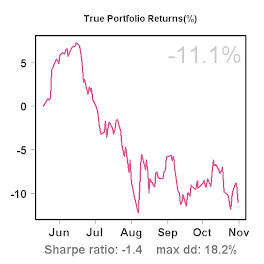Rolling Correlations
We had an interesting discussion today on the C2 forum, and the suggestion was made that correlations (between the returns of trading systems) tend to be unstable over time. To make this visible, you can draw rolling correlations. I.e. to obtain a 50-day rolling correlation, you'd take the returns of two trading systems from day 1 to 50 and calculate the correlation, then take the returns from day 2 to 51 and calculate the next correlation and repeat this until you reach the current date. The result is a curve as shown in red in the figure below.
Besides calculating the 50-day rolling correlation, I also estimated a 95% confidence interval (using a simple bootstrap with 1,000 replications), of which the upper and lower limits are shown in blue.
We can see that the 50-day correlation between extreme-os and Weekend Trader varied between about -0.10 and +0.50, and has increased notably in the past few months (which is not good). This is something I'm probably going to monitor a bit more regularly. (Note that I am trading a modified version of extreme-os, and that the returns on which these correlations are based reflect a backtest of this modified version).
Let's look at the 50-day rolling correlations between the other 2 systems in my portfolio:
The figure seems to suggest extreme-os and Trend Plays #1 have become less correlated over time (which is good!). Finally, 50-day correlations between Weekend Trader and Trend Plays #1 tend to have followed a somewhat cyclical pattern.


1 comment:
Wouldn't it be more sensible to take a rolling correlation over the past fifty days. That would mean a range from t1 till t1 minus 50. In your case you give at time t1 the correlation over the future 50 days, so you will miss the last 50 days.
Hope you will still respond since your post is already quiet old.
Post a Comment